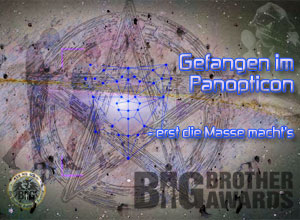

|
search / subscribe / upload / contact |
|
|
||
|
|
||
|
|
||
|
|
||
|
|
||
|
|
||
|
|
||
|
|
||
| RSS-Feed Depeschen | ||

|
||
Date: 1999-01-18
Kryptoblamage.au: Wenn Geheimdienste publizieren-.-. --.- -.-. --.- -.-. --.- -.-. --.- -.-. --.- -.-. --.- Kryptoregelegung verfasst vom gleichnamigen australischen Geheimdienst/vize/chef, wurde für eine Veröffentlichung 1996 geplant, dann blitzartig zurückgezogen, von Electronic Frontiers Australia vermittels Freedom of Information Act gerichtlich angemahnt & im Netze publiziert. In zensurierter Form, so stellt sich jetzt heraus, nachdem ein Student eines der Originale von 96 in einer öffentlichen Bibliothek gefunden hat. Die peinlichen Passagen sind in der "Editio Secunda Walshii" nunmehr knallrot markiert. Alles in allem ein ziemlich komisches Beispiel bürokratischer Inkompetenz, meint Greg Taylor von EFA. http://www.efa.org.au/Issues/Crypto/Walsh/index.htm -.-. --.- -.-. --.- -.-. --.- -.-. --.- -.-. --.- -.-. --.- EFA has obtained access to an uncensored copy of the "Review of Policy relating to Encryption Technologies" (the Walsh Report) and this has now been released online at: http://www.efa.org.au/Issues/Crypto/Walsh/index.htm The originally censored parts are highlighted in red. The story behind this is a rather comical example of bureaucratic incompetence. Revisiting a little history, the report was prepared in late 1996 by Gerard Walsh, former deputy director of the Australian Security Intelligence Organisation (ASIO). The report had been commissioned by the Attorney-General's Department in an attempt to open up the cryptography debate in Australia. It was intended to be released publicly and was sent to the government printer early in 1997. However, distribution was stopped, allegedly at a very high (i.e. political) level. EFA got wind of this and applied for its release under FOI in March 1997. This was rejected for law enforcement, public safety and national security reasons. We persisted, and eventually obtained a censored copy in June 1997, with the allegedly sensitive portions whited out. The report was released on the EFA website, and in the subsequent media coverage the department claimed that the report was never intended to be made public, a claim that is clearly at odds with Gerard Walsh's understanding of the objectives, as is obvious from his foreword to the report. It has now come to light that the Australian Government Publishing Service, which printed the report, lodged "deposit copies" with certain major libraries. This is a standard practice with all Australian government reports that are intended for public distribution. .... To this day, the report remains officially unreleased, except for the censored FOI version. Interestingly, several Australian government sites now link to the report on the EFA website. Quite possibly, this situation would have remained unchanged, except for an alert university student who recently stumbled across an unexpurgated copy of the report, gathering dust in the State Library in Hobart. The uncensored version has now replaced the censored report at the original URL. The irony of this tale is that the allegedly sensitive parts of the report, which were meant to be hidden from public gaze, are now dramatically highlighted. The censored sections provide a unique insight into the bureaucratic and political paranoia about cryptography, such that censorship was deemed to be an appropriate response. The official case for strict crypto controls is now greatly weakened, because much of the censored material consists of unpalatable truths that the administration would prefer to be covered up, even though the information may already be known, or at least strongly suspected, in the crypto community. This apparent unwillingness to admit the truth is an appalling indictment on those responsible for censoring the report. It is indicative of a bureaucracy more anxious to avoid embarrassment and criticism than adhere to open government principles and encourage policy debate. Even worse, the censorship was performed under the mantra of law enforcement and national security, a chilling example of Orwellian group-think. There are also some controversial recommendations in the report that demand attention, since they could well be still on the current policy agenda, in Australia or elsewhere. Examples are proposals for legalised hacking by agencies, legalised trap-doors in proprietary software, and protection from disclosure of the methods used by agencies to obtain encrypted information, an apparent endorsement of rubber- hose code-breaking. On top of all this is the matter of allegedly sensitive material being released to public libraries. It would seem that a number of copies have been gathering dust now for at least a year. So far the sky hasn't fallen, nor has the country succumbed to rampant threats to national security. ... relayed by gtaylor@efa.org.au & tom@lemuria.org -.-. --.- -.-. --.- -.-. --.- -.-. --.- -.-. --.- -.-. --.- - -.-. --.- -.-. --.- -.-. --.- -.-. --.- -.-. --.- -.-. --.- edited by Harkank published on: 1999-01-18 comments to office@quintessenz.at subscribe Newsletter - -.-. --.- -.-. --.- -.-. --.- -.-. --.- -.-. --.- -.-. --.- |
|
|
|
| CURRENTLY RUNNING | |
q/Talk 1.Juli: The Danger of Software Users Don't Control

|
|
| !WATCH OUT! | |
bits4free 14.Juli 2011: OpenStreetMap Erfinder Steve Coast live in Wien

|
|

